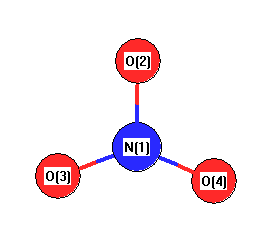.
| squib |
reference |
DOI |
| 1993Dav/Kim:2172 |
HF Davis, B Kim, HS Johnston, YT Lee "Dissociation Energy and Photochemistry of NO3" J. Phys. Chem. 1993, 97, 2172-2180 |
10.1021/j100112a018 |
| 1998Kaw/Ish:193 |
K Kawaguchi, T Ishiwata, E Hirota, I Tanaka "Infrared spectroscopy of the NO3 radical" Chem. Phys. 231, 193-198, 1998 |
10.1016/S0301-0104(97)00386-8 |
| 2002Rie/Tsc:231 |
JC Rienstra-Kiracofe, GS Tschumper, HF Schaefer III, S Nandi, GB Ellison "Atomic and Molecular Electron Affinities: Photoelectron Experiments and Theoretical Computations" Chemical Reviews 2002, 102, 231-282 |
10.1021/cr990044u |
| JANAF |
Chase, M.W., Jr.; Davies, C.A.; Downey, J.R., Jr.; Frurip, D.J.; McDonald, R.A.; Syverud, A.N., JANAF Thermochemical Tables (Third Edition), J. Phys. Chem. Ref. Data,Suppl. 1, 1985, 14, 1. |
|
| VEEL5 |
M.E. Jacox, Vibrational and Electronic Energy Levels of Polyatomic Transient Molecules, J. Phys. Chem.Ref. Data, Monograph 3 (1994) (updated data in NIST Chemistry Webbook - http://webbook.nist.gov/chemistry/ |
|
| webbook |
NIST Chemistry Webbook (http://webbook.nist.gov/chemistry) |
10.18434/T4D303 |











